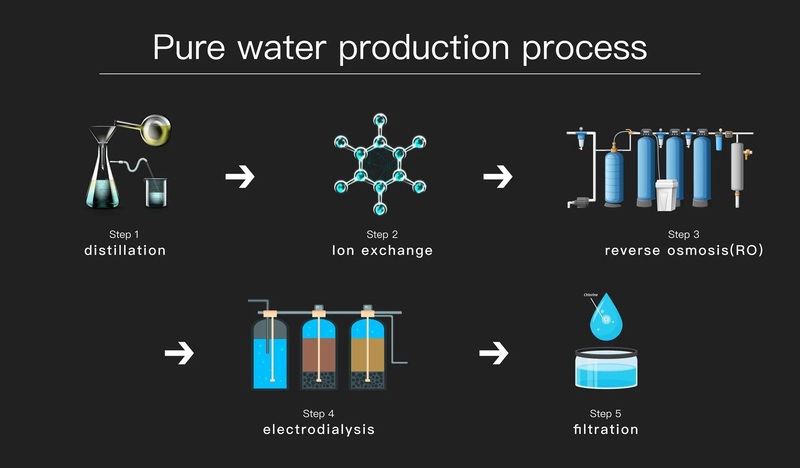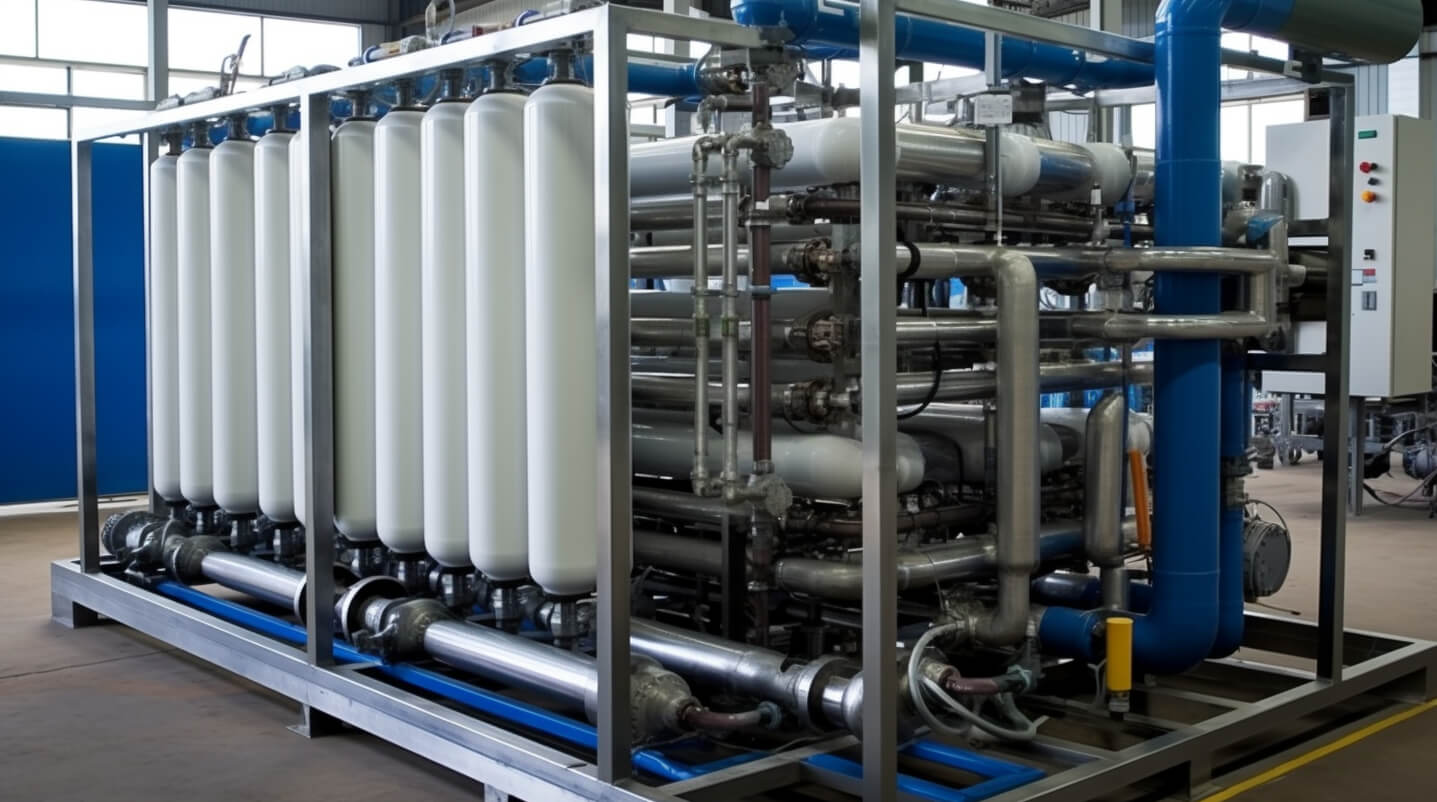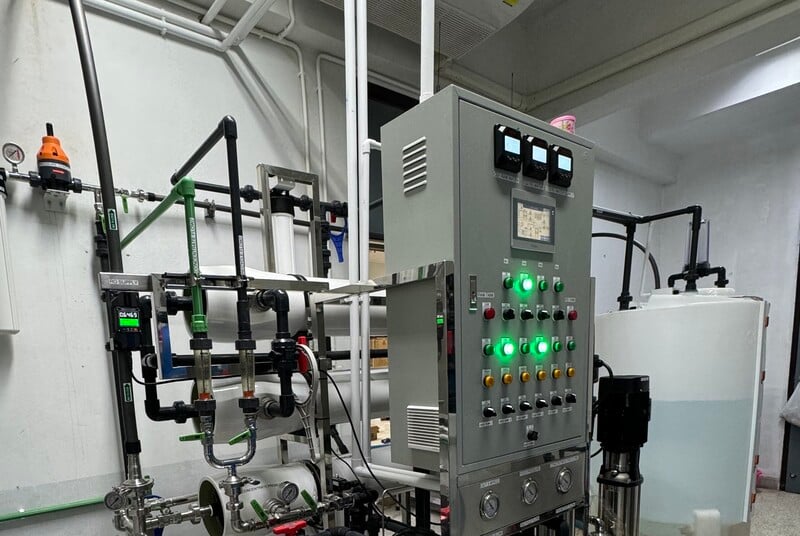น้ำบริสุทธิ์คืออะไร?
น้ำบริสุทธิ์ หรือที่เรียกว่าน้ำอัลตร้าพิวร์ (Ultrapure Water) คือ น้ำที่ผ่านการบำบัดเพื่อกำจัดสิ่งเจือปนและไอออนส่วนใหญ่ เหลือเพียงโมเลกุลน้ำ (H₂O) เท่านั้น ในขณะที่น้ำดื่มทั่วไป รวมถึงน้ำแร่บรรจุขวดยังมีสิ่งเจือปนอยู่บ้าง แต่โดยทั่วไปสิ่งเหล่านั้นไม่เป็นอันตรายต่อสุขภาพ
ในไต้หวัน ระบบน้ำประปาผ่านการตรวจสอบและรับรองจาก สำนักงานคุ้มครองสิ่งแวดล้อม (EPA) ตามมาตรฐาน “คุณภาพน้ำดื่ม” ซึ่งสอดคล้องกับมาตรฐานสากล เช่น องค์การอนามัยโลก (WHO) เพื่อให้มั่นใจว่าปลอดภัยสำหรับการบริโภคในชีวิตประจำวัน ดังนั้นสำหรับการใช้งานทั่วไปจึงไม่มีความจำเป็นต้องดื่มน้ำบริสุทธิ์
น้ำบริสุทธิ์ถูกนำไปใช้ในอุตสาหกรรมและอุปกรณ์ทางการแพทย์เฉพาะทาง เช่น การผลิตแผ่นเวเฟอร์เซมิคอนดักเตอร์ การผลิตยา เลนส์ออปติคัล และการทำความสะอาดเข็มฉีดยาทางการแพทย์
ตลาดน้ำอัลตร้าพิวร์มีการเติบโตอย่างรวดเร็ว โดยเพิ่มจาก 9.07 พันล้านดอลลาร์ในปี 2022 เป็น 10.05 พันล้านดอลลาร์ในปี 2023 และคาดว่าจะเพิ่มขึ้นเป็น 13.76 พันล้านดอลลาร์ภายในปี 2027
ปัจจัยสำคัญที่ขับเคลื่อนการเติบโตของตลาดนี้คือการใช้งานที่เพิ่มขึ้นในอุตสาหกรรม เช่น การผลิตเซมิคอนดักเตอร์ ซึ่งน้ำอัลตร้าพิวร์มีบทบาทสำคัญในการขจัดสิ่งปนเปื้อน แร่ธาตุ จุลินทรีย์ และสารอินทรีย์และอนินทรีย์ต่าง ๆ ในแต่ละขั้นตอนของกระบวนการผลิต เพื่อให้มั่นใจในคุณภาพและประสิทธิภาพของผลิตภัณฑ์
[1]
น้ำประปาดื่มได้หรือไม่?
เมื่อพิจารณาว่าน้ำประปานั้นปลอดภัยสำหรับดื่มหรือไม่ สิ่งสำคัญคือต้องเข้าใจวคุณภาพน้ำอาจแตกต่างกันอย่างมากในแต่ละพื้นที่ ปัจจัยต่างๆ รวมถึงแหล่งน้ำ กระบวนการบำบัดที่น้ำต้องผ่าน และสภาพแวดล้อมในท้องถิ่นมีผลต่อความปลอดภัยและรสชาติของน้ำประปา
แหล่งน้ำและการบำบัด: น้ำประปามักมาจากแหล่งน้ำผิวดินหรือแหล่งน้ำใต้ดิน และจะผ่านกระบวนการบำบัดหลายขั้นตอนเพื่อลบสิ่งปนเปื้อนและเชื้อโรค กระบวนการเหล่านี้รวมถึงการกรอง การตกตะกอน และการฆ่าเชื้อ ในพื้นที่ที่แหล่งน้ำมีมลพิษสูงหรือมีการบำบัดน้ำไม่เพียงพอ น้ำประปาอาจไม่ตรงตามมาตรฐานความปลอดภัยในการดื่ม
ความแปรผันตามพื้นที่: คุณภาพของน้ำประปาอาจแตกต่างกันมากตามแต่ละพื้นที่ ตัวอย่างเช่น ในบางรัฐเกาะเล็กในแคริบเบียน แหล่งน้ำหลักแตกต่างกันไปตามภูมิประเทศและธรณีวิทยา เกาะบางแห่งพึ่งพาน้ำใต้ดิน ในขณะที่บางเกาะพึ่งพาน้ำผิวดิน การลดลงของคุณภาพน้ำผิวดินจากมลพิษจากน้ำทิ้งการเกษตรและเมือง กิจกรรมอุตสาหกรรม และการบำบัดน้ำเสียที่ไม่เพียงพอเป็นปัญหาสำคัญในพื้นที่เหล่านี้
ความขาดแคลนน้ำและความเครียดจากน้ำ: ในพื้นที่ที่ประสบกับความขาดแคลนน้ำหรือความเครียดจากน้ำ คุณภาพน้ำประปาอาจถูกทำลาย ตัวอย่างเช่น ในแคริบเบียน บางเกาะเผชิญกับความขาดแคลนน้ำอย่างสิ้นเชิง ทำให้ยากที่จะตอบสนองความต้องการน้ำพื้นฐานและรักษามาตรฐานคุณภาพ
ตลาดน้ำและการจัดการ: ตลาดน้ำและกลยุทธ์การจัดการน้ำก็มีบทบาทในการกำหนดคุณภาพน้ำ กลยุทธ์เหล่านี้รวมถึงการเพิ่มการจัดหาน้ำ การจัดการความต้องการ และการใช้ตลาดน้ำในการจัดการทรัพยากรน้ำที่ขาดแคลนอย่างมีประสิทธิภาพ ความสามารถในการดำเนินการของกลยุทธ์เหล่านี้สามารถมีผลต่อความพร้อมและคุณภาพของน้ำประปา
โดยสรุปแล้ว แม้ว่าน้ำประปาในหลายๆ พื้นที่ โดยเฉพาะในพื้นที่ที่มีสิ่งอำนวยความสะดวกในการบำบัดน้ำที่ทันสมัย จะปลอดภัยต่อการดื่ม แต่ก็ยังคงต้องพิจารณาสภาพท้องถิ่นและข้อบังคับ ในพื้นที่ที่มีปัญหาคุณภาพน้ำที่ทราบ อาจจำเป็นต้องใช้แหล่งน้ำทางเลือกเช่น น้ำขวดหรือระบบการกรองน้ำ การตรวจสอบรายงานคุณภาพน้ำท้องถิ่นหรือการปรึกษากับเจ้าหน้าที่สาธารณสุขในท้องถิ่นเป็นแนวทางที่ดีในการได้รับข้อมูลที่ถูกต้องและเป็นปัจจุบันเกี่ยวกับความปลอดภัยของน้ำประปาในพื้นที่ของคุณ
[2][3]
กระบวนการบำบัดน้ำบริสุทธิ์
ระบบน้ำบริสุทธิ์มีความสำคัญอย่างยิ่งในอุตสาหกรรม เช่น เซมิคอนดักเตอร์ การผลิตจอ LCD และ อิเล็กทรอนิกส์ความแม่นยำสูง ซึ่งวงจรภายในผลิตภัณฑ์ต้องการน้ำที่มีความบริสุทธิ์สูงมาก เนื่องจากสิ่งเจือปนในน้ำล้างสามารถลดอัตราการผลิตได้อย่างมาก
โดยเฉพาะในอุตสาหกรรมเซมิคอนดักเตอร์ จำเป็นต้องใช้น้ำอัลตร้าพิวร์ (Ultrapure Water) ซึ่งสะอาดกว่าน้ำประปาถึง 1,000 เท่า สำหรับกระบวนการที่สำคัญ เช่น การล้างโฟโตมาสก์ (Photomask Cleaning) การล้างเวเฟอร์ (Wafer Washing) การกัดกรด (Etching) และการขัดพื้นผิวเชิงกล (Mechanical Polishing) เพื่อให้มั่นใจในคุณภาพของผลิตภัณฑ์

กระบวนการเตรียมน้ำบริสุทธิ์มักประกอบด้วยเทคโนโลยีหลายประการเพื่อให้ได้น้ำที่มีความบริสุทธิ์สูง ขั้นตอนทั่วไปประกอบด้วย:
การกลั่น: กระบวนการในการให้ความร้อนน้ำจนกลายเป็นไอและจากนั้นจะควบแน่นกลับเป็นของเหลวเพื่อขจัดสิ่งสกปรกและไอออน เป็นวิธีที่มีประสิทธิภาพแต่ใช้พลังงานสูง
เรซินแลกเปลี่ยนไอออน: เรซินเหล่านี้ขจัดไอออนจากน้ำและมักใช้ในการบำบัดน้ำ ตัวแลกเปลี่ยนไอออนแบบผสมผสานจะรวมเรซินแลกเปลี่ยนแคทไอออนและแอนไอออนเพื่อความบริสุทธิ์ที่สูงขึ้น
การออสโมซิสย้อนกลับ (RO): RO ใช้เยื่อหุ้มเซมิปอรัสเพื่อกรองสิ่งสกปรกและไอออน โดยทั่วไปใช้ในการผลิตน้ำที่บริสุทธิ์สูง โดยเฉพาะในห้องปฏิบัติการ ยา และการผลิตอิเล็กทรอนิกส์
อิเล็กโทรไดอาไลซิส: เทคนิคนี้แยกไอออนออกจากน้ำโดยใช้สนามไฟฟ้าและมักใช้ในการทำให้น้ำปราศจากไอออน
การกรอง: ไมโครฟิลเตอร์จะขจัดอนุภาคเล็กๆ และสารปนเปื้อน เพิ่มความบริสุทธิ์ของน้ำอีกขั้น
อุตสาหกรรมน้ำบริสุทธิ์ประกอบด้วยหลายภาคส่วน เช่น ผู้ผลิตอุปกรณ์ ผู้พัฒนาเทคโนโลยีการบำบัดน้ำ และบริษัทที่เกี่ยวข้องกับการจัดหาน้ำสะอาด อุตสาหกรรมที่หลากหลายนี้มีบทบาทสำคัญในการจัดหาน้ำสะอาดสำหรับการใช้งานต่างๆ รวมถึงกระบวนการผลิตที่มีความแม่นยำสูง
[4]
การใช้งานเครื่องวัดการไหลในอุตสาหกรรมน้ำบริสุทธิ์
ในอุตสาหกรรมน้ำบริสุทธิ์ เครื่องวัดการไหล (Flow Meters) ถูกใช้เพื่อ ตรวจสอบและควบคุมการไหลเข้าและไหลออกของน้ำ ในกระบวนการบำบัดน้ำ เพื่อให้มั่นใจว่ากระบวนการผลิตมีประสิทธิภาพและเป็นไปตามมาตรฐานคุณภาพน้ำ
เมื่อใช้งานร่วมกับ แผงควบคุม (Control Panels) เครื่องวัดการไหลช่วยควบคุมการไหลของ น้ำกรองและสารเคมี ที่เข้าสู่ระบบ ซึ่งมีความสำคัญในการรักษาคุณภาพน้ำบริสุทธิ์ เครื่องวัดการไหลที่มี สัญญาณอิเล็กทรอนิกส์ (Electronic Signal Output) ยังช่วยเพิ่มความแม่นยำในการตรวจสอบ และช่วยเพิ่มประสิทธิภาพในกระบวนการผลิตน้ำบริสุทธิ์ให้ดียิ่งขึ้น

กรณีศึกษา: ผู้ผลิตอุปกรณ์บำบัดน้ำรายใหญ่ในภาคกลางของไต้หวัน
สถานการณ์: บริษัทใช้มาตรวัดการไหลแบบพัดลมชนิดแทรกยี่ห้อสวิสในอุปกรณ์การบำบัดน้ำของพวกเขา แต่การวัดการไหลเหล่านี้ไม่มีหน้าจอและความสามารถในการตรวจสอบการไหลแบบเรียลไทม์ ลูกค้าต้องการติดตั้งมาตรวัดการไหลที่สามารถให้เจ้าหน้าที่ในสถานที่สามารถตรวจสอบการไหลของของเหลวได้อย่างสะดวก
ทางออก: มาตรวัดการไหลแบบพัดลม AxleSense ของ LORRIC ที่ได้รับสิทธิบัตร
มาตรวัดการไหลแบบพัดลม AxleSense มีข้อดีในเรื่องการออกแบบหน้าจอคู่ LCD/LED ซึ่งสามารถให้ค่าการอ่านการไหลของท่อได้อย่างชัดเจน แม้ในสภาพแวดล้อมที่มีแสงน้อยหรือเมื่อเครื่องอยู่ห่างจากแผงพลาสติก นอกจากนี้มาตรวัดนี้ยังสามารถตรวจสอบการไหลทันที การไหลสะสม ความเร็วการไหลทันที และสามารถให้บันทึกการสะสมของการไหลเชิงบวก/เชิงลบ/สุทธิในช่วง 14 วันที่ผ่านมา ซึ่งไม่เพียงแต่ตรงตามความต้องการของลูกค้า แต่ยังช่วยให้เจ้าหน้าที่ในสถานที่สามารถเข้าถึงข้อมูลการไหลที่ละเอียดมากขึ้น

กรณีศึกษา: ผู้ผลิตระบบรีเวิร์สออสโมซิสในภาคเหนือของประเทศไทย
สถานการณ์: บริษัทผู้ผลิตและติดตั้งระบบรีเวิร์สออสโมซิสในภาคเหนือของประเทศไทย
บริษัทที่เชี่ยวชาญในการผลิตและบูรณาการระบบรีเวิร์สออสโมซิสเคยใช้ เครื่องวัดการไหลแบบลูกลอย (Area Flow Meters) ซึ่งไม่สามารถบันทึกข้อมูลและไม่ตอบโจทย์การตรวจสอบแบบดิจิทัลในปัจจุบัน ด้วยความก้าวหน้าทางเทคโนโลยีและความต้องการที่เพิ่มขึ้นในการตรวจสอบการไหลที่แม่นยำ ลูกค้า จึงมองหาเครื่องวัดการไหลที่สามารถ ตรวจสอบการไหลของของเหลวแบบเรียลไทม์ ได้หน้างาน และ รองรับการเชื่อมต่อกับแผงควบคุม PLC เพื่อเพิ่มประสิทธิภาพการทำงาน
ทางออก: FU-ES EchoSense Clamp-on Ultrasonic Flow Meter
LORRIC ได้จัดหา FU-ES clamp-on ultrasonic flow meter ซึ่งมีเทคโนโลยีการวัดทางอิเล็กทรอนิกส์ขั้นสูงสำหรับการตรวจสอบการไหลแบบเรียลไทม์และเอาท์พุตดิจิตอล ซึ่งเหมาะสำหรับการเชื่อมต่อกับระบบ PLC นอกจากนี้ มาตรวัดนี้ยังรองรับการบันทึกข้อมูลผ่านอินเทอร์เฟซดิจิตอล ช่วยให้ลูกค้าสามารถวิเคราะห์และปรับกระบวนการผลิตได้ดียิ่งขึ้น ลูกค้าได้แสดงความพึงพอใจในประสิทธิภาพของ FU-ES และมีแผนที่จะขยายการใช้อุปกรณ์ดังกล่าวเพื่อตอบสนองความต้องการที่เพิ่มขึ้นของตลาด